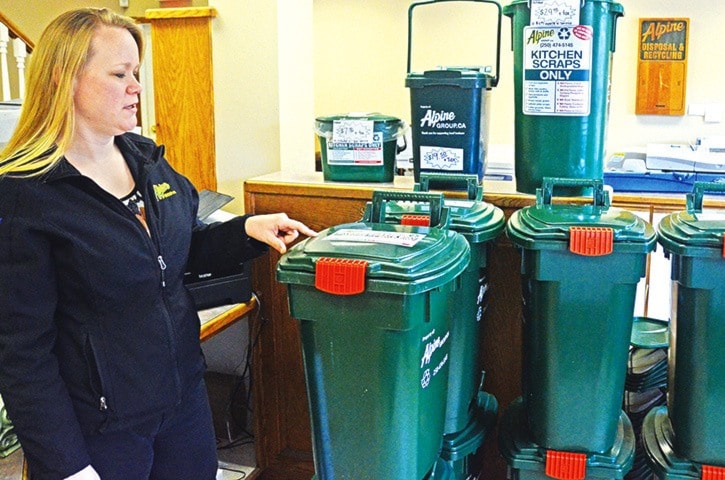As of Jan. 1, West Shore residents had to find an alternative to their garbage can for their food scraps, due to a ban implemented on kitchen waste at the Hartland Landfill.
Before this year, organic materials such as food waste and kitchen scraps made up approximately 30 per cent of the waste at Hartland Landfill, according to the Capital Regional District. In an attempt to extend the life of the landfill, as well as encourage the production of material such as compost and fertilizer, Hartland has been phasing out organic waste at the facility over the last three years, culminating with the full ban on Jan. 1.
Alpine Disposal and Recycling, as one of the major waste haulers in the region, is excited about the new regulations, and has revamped its services in order to help the community abide by them.
“Much of Victoria – Oak Bay, James Bay, View Royal, for example – have already been doing the program for a while now,” says Heather Baumann, office manager of the Alpine facility on Dunford Avenue in Langford.
“But it wasn’t mandatory, so we were just picking up garbage, and going along our merry little way. But then the ban came into effect at the landfill, so then we’re in the middle as the hauler, and we’re going, ‘OK, we need to come up with a plan so that there are options out there for people.’”
That plan was to create a diverse combination of offerings for people.
That included providing curbside residential pickup in conjunction with what they already do in terms of garbage collection, to large bins for commercial facilities like restaurants and grocery stores, to drop-off at their Langford facility, incorporating education on other waste management practices like composting.
 “It’s not mandatory for them to sign up with us, but it’s mandatory for them to have some alternative for their kitchen-scrap waste,” Baumann says.
“It’s not mandatory for them to sign up with us, but it’s mandatory for them to have some alternative for their kitchen-scrap waste,” Baumann says.
“If they’re composting using back yard composters, great. If they’re garburating, great. But if they’re not doing any of that, it means it’s going in the garbage, right? We wanted to have options for our customers, because they can’t be doing that anymore.”
And she says people are getting on board.
Throughout December, she says, they had lineups out the door and had trouble keeping up with demand for household receptacles. She also says there will always be some resistance to new things, but she feels people will eventually come to terms with it.
“When the Blue Box program came in, it was the same thing,” Baumann says. “People said, ‘I’m not going to sort my cans and glass,’ but now you drive around Langford and Colwood on Blue Box day and some houses have seven boxes out. It’s just a matter of people getting used to it.”
A big part of getting people used to it is just a matter of letting people know what they need to do to comply, and give them the options to make it easy to do so.
“We’re doing our best to comply with the ban, give people options and educate them. It’s all new to people, and there hasn’t been a lot of information flowing to the residents. Some people are excited, because they’ve been waiting for this to finally happen … We don’t want people to see it as an inconvenience.”
“It’s adding something – an extra service to help the residents comply with the ban. We’re happy to take phone calls from people with questions, and we do a lot of that,” she says, because there are a lot of options for people.
The base cost for curb side pickup for kitchen and food scraps is $4.95 per month – in addition to your garbage service pickup costs – which includes the containers (provided by Alpine), pickup and processing of the waste. Kitchen scrap pickup happens alongside garbage pickup, and on the same day, and sometimes even using the same truck.
“We do get calls with angry people who say, ‘I went through the effort to separate it, and you just threw it in the garbage anyway,’” Baumann says, which is when they need to explain that they have retrofitted some of their trucks to have separate compartments for kitchen scraps, so it only appears it’s all going to the same place.
Another option for residential food waste is to purchase the containers and bring them to a drop off location like Alpine’s or directly to the landfill yourself.
Or, of course, you can do at-home composting, which is an excellent way to make your own nutrient-rich soil for gardening, and fully encouraged by the CRD.
Meat, bones, fat, grains and cooked foods shouldn’t be just thrown in a pile of dirt in a backyard compost bin, however, but Green Cone digesters – which treat these products – have now been piloted in the region. More information on Green Cone digesters can be found either by contacting the Greater Victoria Compost Education Centre at compost.bc.ca or 250-386-WORM (9676) or by finding the downloadable brochure on the CRD’s website under the “Regional Kitchen Scraps Strategy” section.
